[Retracted] Recognition, Processing, and Detection of Sensor Fault Signal Based on Genetic Algorithm
Abstract
With the development of electronic information science and network transmission technology, signal processing technology is widely used in various fields. The processing of sensor coarse signal is the key of signal processing technology, in order to study the signal detection and transmission function of the sensor. A genetic algorithm-based sensor fault signal identification, processing, and detection are proposed, and three common signal analysis and processing methods are summarized. The methods of optimal arrangement of sensors are as follows: effective independent algorithm, genetic algorithm, simulated annealing algorithm, and ant colony algorithm principle are studied in detail; signal analysis methods are as follows: fast Fourier transform, wavelet transform, and HHT transform are studied in detail. In the experimental system of the sensor’s coarse signal processing mode, the optimal arrangement of the measurement points of the acceleration sensor in this experiment is directly related to the information collection effect of the monitoring system. Combined with numerical simulation and engineering cases, the soft computing (genetic algorithm, simulated annealing algorithm, and ant colony algorithm) is analyzed in detail, out of the MATLAB program for soft computing. Taking four typical functions as the numerical experimental platform, the three algorithms are used for comparative experimental analysis, and their optimized performance and application range are analyzed. Finally, the practical application performance of soft computing is tested by the practical application problem of optimal path optimization of measuring points. When there are only 10 measuring points, all three algorithms can quickly converge to the global optimal solution, but when there are 100 measuring points, only approximate solutions can be obtained.
1. Introduction
Due to the development of data-processing technology, a large number of algorithms have appeared in data mining and processing technology. The control of power signals in the power communication process is a relatively complicated process, and the identification, acquisition, and amplification of power signals are relatively tedious processes. At present, the power signal has been successfully displayed on the PC 32-bit machine, but the 32-bit machine system is more complicated. In order to display the signal conveniently and efficiently, the rough signal is amplified through experimental study, and the mathematical model of the genetic algorithm sensor coarse signal processing is used to compile the embedded signal recognition, acquisition, and amplification program. Through signal selection, cross-over, and mutation processing, the processing of sensor coarse signal is successfully realized, and a series of signal recognition and enlarged pictures are obtained, which provides a theoretical basis for the research of power signal processing technology [1]. The adaptive genetic algorithm is a data-processing method that generates random sequences and then progressively achieves control objectives through the fuzzy control theory. This data-processing method can make data processing more efficient and reliable and has strong stability. The main realization process of the adaptive genetic algorithm is to first determine the target of signal preprocessing, then to distinguish and select the signal through fuzzy control theory, and finally to realize the AD transformation of the coarse signal through the cross-over and mutation of the signal data. If the health status of the bridge is monitored and evaluated in time, the probability of sudden bridge collapse will be greatly reduced. The establishment of an effective bridge health monitoring system can not only avoid the partial or overall loss and damage of the bridge structure during the operation to a large extent but also provide the status information of the bridge at all times. Therefore, the bridge maintenance managers can obtain a large amount of decision-making information through the bridge health monitoring system. The ideal bridge health monitoring system should have powerful biomimetic functions, such as automatic monitoring, automatic diagnosis, automatic transmission, automatic processing, and even automatic repair functions.
2. Literature Review
The genetic algorithm is a random search algorithm that simulates the survival of the fittest by natural selection. Li et al. found that genetic algorithm has fast calculation speed and a wide application range when solving optimization problems. Its main feature is to directly calculate and process the optimization target. As a random search and iterative optimization algorithm, the genetic algorithm has potential parallelism and global optimization ability with no differentiable and continuous limitation on objective function [2]. Zhang and others proposed the Wireless Sensor and Actuator Network (WSAN), each sensor node in the system senses and collects the changes of the monitoring object, and transmits the information to the actuator for real-time response [3]. Jiang and others found that WSAN is widely used in various fields, including military weapons, industrial systems, environmental sanitation detection, and target tracking [4]. Ren found that the fault detection of WSAN is the key to improving the performance of WSAN [5]. Liang et al. proposed that the key to WSAN fault detection is system state observation and signal filtering, that is, adding a dynamic system based on a state observer on the basis of measuring the input and output signals of the industrial system (that is, fault detection filter) to generate a residual signal containing fault information, delay information, and noise. Through signal processing and filtering, the fault information component in the residual signal is amplified, and the noise component is suppressed [6]. Kumar and Mathusoothana found that the current application of the genetic algorithm in the WSAN field is mainly concentrated in the field of routing analysis and location. While the design of the fault detection filter is mainly concentrated in the field of feature root optimization [7]. Yuan et al. found that the method of using the eigen-root optimization method to solve the gain matrix has a continuous limitation on the optimization objective function; when the system transfer matrix is not a full-rank matrix, the error of this method is relatively large, and there may even be multiple solutions. When the complexity of optimizing the objective function increases, the difficulty of solving by characteristic roots will be greatly increased [8]. Mokhlessi and others proposed to introduce a genetic algorithm into the design of the WSAN fault detection filter. The global optimal solution of the gain matrix of fault detection filter is obtained by the genetic algorithm, which overcomes the “dead cycle” phenomenon that the general iterative method is easy to fall into the trap of local minimum [9]. Cao et al. found that the inherent delay of the wireless network is modeled as the noise in the system, which avoids the difficulty of obtaining the Markov transition matrix that is often encountered when other methods solve similar problems. The objective function that meets the robustness and sensitivity compliance index is taken as the fitness function to improve the performance index of the gain matrix [10]. Park and Park found that the embedded adaptive genetic algorithm programming in the sensor coarse signal processing system realized the recognition, collection, and processing of the sensor coarse signal, and the effect of the sensor coarse signal processing was obtained as shown in Figure 1 [11]. Wang et al. found that the genetic algorithm includes coding, selection, cross-over, and mutation operations. The selection operation is the core of the entire genetic algorithm to solve the optimal gain matrix L. By selecting the appropriate fitness function, the evolution direction is given, so that the solution results keep approaching the best result [12].

3. Methods
3.1. Theoretical Study on Optimal Layout of Health Monitoring Sensors
The i-th element on the diagonal of the matrix E represents the importance of the i-th measuring point to the rank of the matrix ΦS. If Eii = 1, it means that the measuring point i is a key point in the modal matrix, and the measuring point i needs to be retained. Otherwise, if E = o, it means that the required modal vector cannot be distinguished by measuring point i, and measuring point i is excluded. The candidate measuring points are sorted in the order of the size of E, the point with the smallest E is eliminated in each iteration, and until the optimal number of measurement points is reached, the iterative calculation is terminated. In order to obtain a nonsingular Fisher matrix, the number of target modes m, and the number of sensors must remain the same, which is a shortcoming that cannot be ignored in this method [15–17].
The genetic algorithm is derived from the theory of biological evolution. Individuals with less adaptability are eliminated, and individuals who adapt to the environment have a greater probability of surviving and producing offspring. The disaggregation search method and the information intersection between disaggregation strings are two important characteristics. The main steps and the basic flow chart of the algorithm are shown in Figure 2.

- (1)
Change the objective function to be solved into a fitness function: if the objective function is a maximization problem, then Fit(f(x)) = f(x). If the objective function is a minimal problem, then Fit(f(x)) = f(x)
- (2)
If the objective function is the minimum problem and cmax is the maximum estimate of f(x), then
- (3)
If the objective function is the minimum problem
3.2. Algorithm Numerical Experiment Platform
- (1)
Sphere function: . It is almost the simplest smooth convex function, the maximum value f(max) = Jf(5.5) = 10, and there is only one maximum coordinate point
- (2)
Step function: f1(x1, x2) = 12 − [x1] − [x2] − 10 < x1, x2 < 10. [] means rounding, and it is a discontinuous step function. If the search step in the algorithm is fixed, it is difficult to find the global optimal solution. The maximum value is , and there are a certain number of maximum coordinate points
- (3)
Rosenbrock function: . It is an ill-conditioned unimodal function, which requires a higher search direction of the algorithm, and it is difficult to find the maximum value in general methods. The maximum value is
- (4)
Schaffer function: . The maximum value of the function is , and the second maximum value 0.99028 appears on a circle with a radius of 3.14 from the maximum coordinate point. Because the maximum value and the maximum value are separated by a circle of troughs, the algorithm is easy to fall into the local optimal solution 0.99028
- (1)
Genetic algorithm: the number of binary codes is 30, the population size is 80, and the selection ratio, cross-over probability, and mutation probability are, respectively, 0.8, 0.8, and 0.2
- (2)
Simulated annealing algorithm: the Markov chain length is 1000, attenuation parameter is 0.95, step factor is 0.02, initial temperature is 30, tolerance of function sphere and function step is 0.001, tolerance of the function Rosenbrock is 0.00001, and tolerance of the function Schaffer is 5 × e−7
- (3)
Ant colony algorithm: take 200 ants, the grid unit is 0.05, the number of ants movement is 1000, and the volatilization coefficient and transition probability are, respectively, 0.8 and 0.2
4. Results and Analysis
In the comparison test, the genetic algorithm, simulated annealing algorithm, and ant colony algorithm can be solved according to the rational programming. Because the running performance and solution results of the intelligent algorithm have a great relationship with the startup parameters of the program, it is necessary to determine the startup parameters of each operation before testing and try to keep the basic parameters of the three algorithms consistent.
4.1. Genetic Algorithm
The number of encoded binaries is 30, the population size is 80, and the selection ratio, cross-over probability, and mutation probability are, respectively, 0.8, 0.8, and 0.2.
4.2. Simulated Annealing Algorithm
The Markov chain length is 1000, the decay parameter is 0.95, the step factor is 0.02, the initial temperature is 30, the function sphere and the function step tolerance are 0.001, the function Rosenbrock tolerance is 0.00001, and the function Schaffer tolerance is 5 × e7.
4.3. Ant Colony Algorithm
Take 200 ants, take 0.05 for grid unit, take 1000 ants to move, and take 0.8 and 0.2 for volatility coefficient and transition probability, respectively.
First, the genetic algorithm is used to optimize the four typical functions, and the convergence graphs of the function values are shown in Figures 3–6.
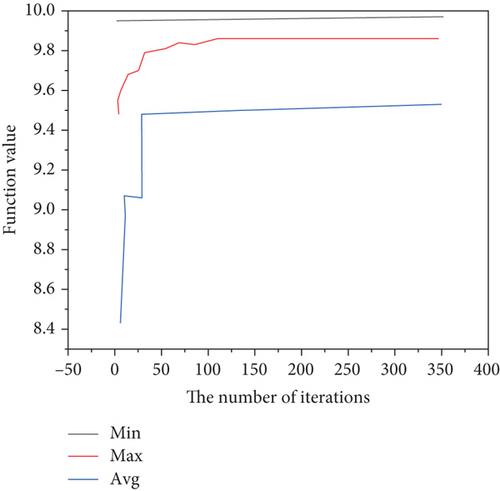
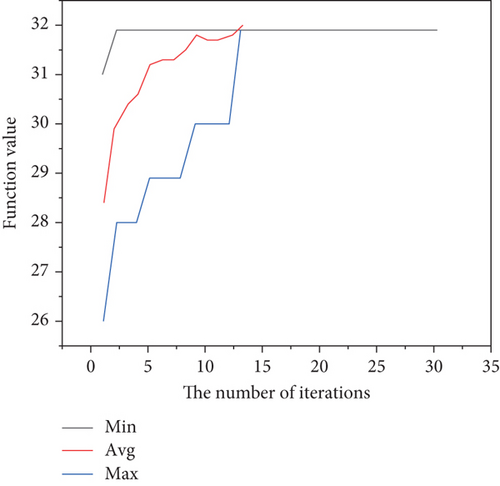
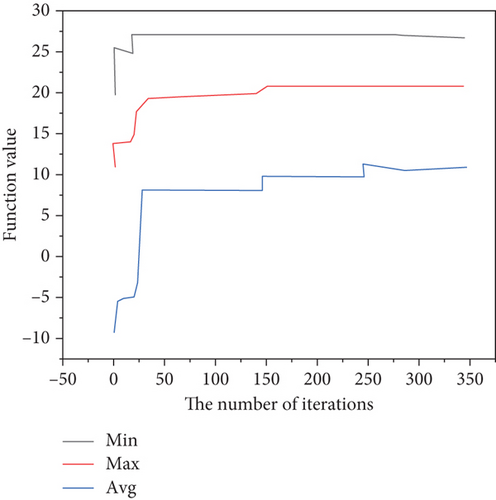
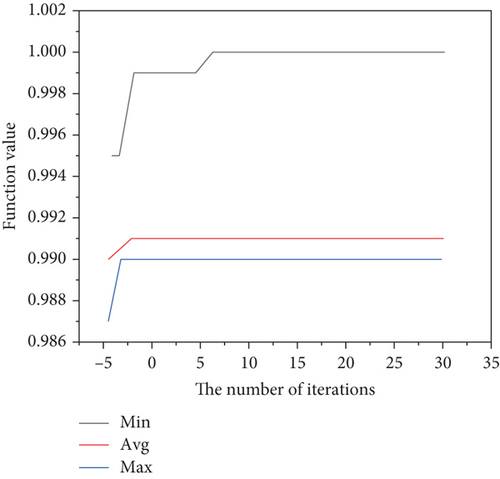
The simulated annealing algorithm is used to optimize these four typical functions, and the convergence graphs of the function values are shown in Figures 7–10. For the step function, it is easy to fall into an endless loop, but the optimal solution has been solved; because of the error, it has not been able to jump out of the loop [26, 27].

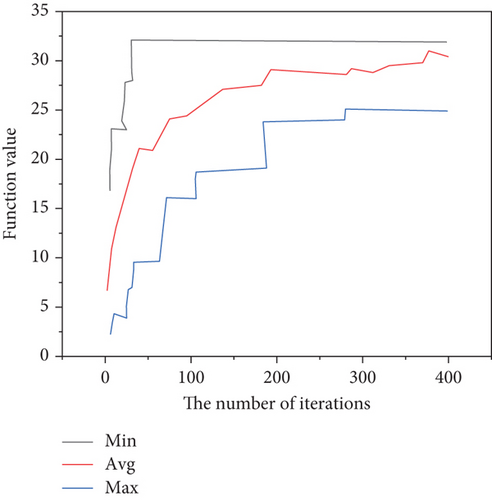
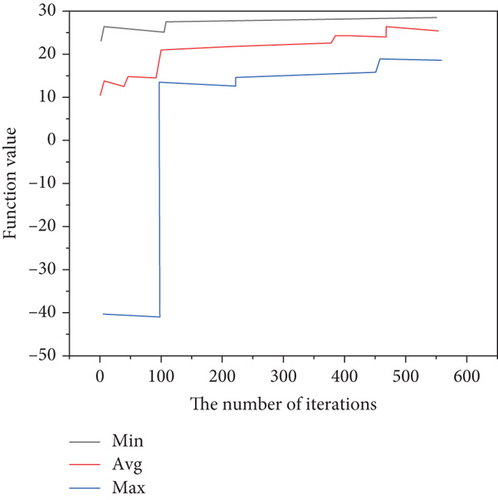
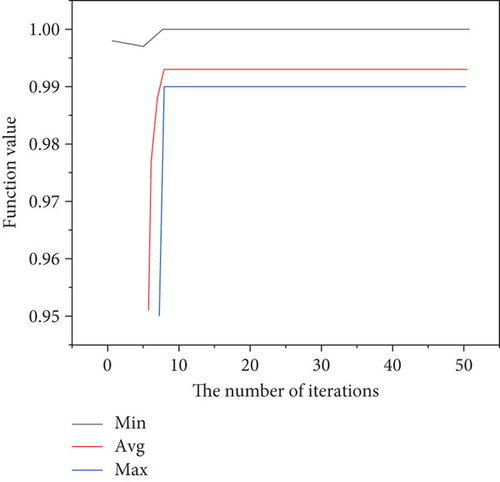
Finally, the ant colony algorithm is used to optimize these four typical functions, and the convergence graphs of the function values are shown in Figures 3–10. The initial position of the ants on each function surface is 200 ants randomly generated by the program, and then through the ant colony algorithm program based on the optimization principle, the ants start to find the target value (it is reflected in the program to find the maximum value). After 1000 times of iterations, for the sphere function, 200 ants quickly gathered to the vertices of the surface, from the convergence graph of the step function and the distribution of ants.
The convergence of the genetic algorithm, simulated annealing algorithm, and ant colony algorithm is analyzed in detail in this paper, and then MATLAB is used to write the programs of these three algorithms. Taking sphere function, step function, Rosenbrock function, and Schaffer function as examples, these three algorithms are used for comparative experimental analysis, and their optimization performance and scope of application are analyzed [28, 29]. Results show that genetic algorithm, simulated annealing algorithm, and ant colony algorithm have good optimization effects for solving general function problems, variable step-size problems, and ill-conditioned problems. Aiming at the practically more complex application problem of optimal path optimization of measuring points, the practical application performance of the genetic algorithm, simulated annealing algorithm, and ant colony algorithm is tested, the feasibility of different algorithms is analyzed through the solution results, and the calculation efficiency and characteristics of each are compared and analyzed. When there are only 10 measuring points, all three algorithms can quickly converge to the global optimal solution. However, when there are 100 measuring points, only approximate solutions can be obtained. It is found that the ant colony algorithm and the simulated annealing algorithm are closer to the optimal solution, and the convergence speed is faster, while the genetic algorithm is more mature in program implementation with lower requirements for initial parameters.
According to the optimization of the experiment, the genetic annealing algorithm, simulated annealing algorithm, and ant colony algorithm have their own advantages and disadvantages, but on the whole, they have good convergence and robustness for the four types of problems and can be obtained within a certain error range. Satisfactory results can be applied to the optimization of practical problems. Therefore, the next section will focus on practical problems, and these three algorithms should be optimized and solved in order to compare their actual application performance.
5. Conclusion
The establishment of a health monitoring system requires the support of a lot of cross-disciplinary knowledge and involves the processing of a large amount of monitoring information. In order to effectively identify the modal parameters and force behavior of the bridge from the massive data, it is often necessary to resort to soft computing. In view of the current information processing problems in health monitoring, soft computing (genetic algorithm, simulated annealing algorithm, and ant colony algorithm) in the optimization layout of measuring points in the health monitoring system, and the application of soft computing (FFT transform, WT transform, and HHT transform) in monitoring signal analysis and processing are mainly studied in the paper. Research on the applicability of the optimization algorithm for measuring points of health monitoring sensors is studied, and the convergence of soft computing (genetic algorithm, simulated annealing algorithm, and ant colony algorithm) is analyzed in detail. The sphere function, step function, Rosenbrock function, and Schaffer function are taken as the numerical experiment platform to analyze their optimized performance and scope of application by comparative experimental analysis. It shows that genetic algorithm, simulated annealing algorithm, and ant colony algorithm have good optimization effects for solving general function problems, variable step-size problems, and ill-conditioned problems. The practical application problem of optimal path optimization for measuring points is used to test the practical application performance of the genetic algorithm, simulated annealing algorithm, and ant colony algorithm. When there are only 10 measuring points, all three algorithms can quickly converge to the global optimal solution, but when there are 100 measuring points, only approximate solutions can be obtained. It is found that the ant colony algorithm and the simulated annealing algorithm are closer to the optimal solution, and the convergence speed is faster, while the genetic algorithm is more mature in program implementation with lower requirements for initial parameters. The modal parameters extracted from the finite element model are the basis for the optimal arrangement of the acceleration sensor in this paper. Therefore, the difference between the finite element model and the actual bridge may have an adverse effect on the final optimization effect of the sensor. Its degree of effectiveness is worth further research.
Conflicts of Interest
The author declares no competing interests.
Open Research
Data Availability
The data used to support the findings of this study are available from the corresponding author upon request.




